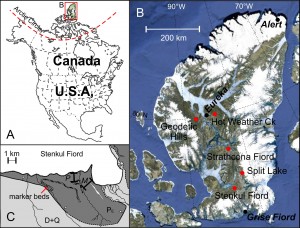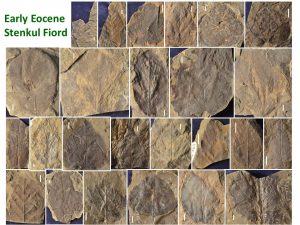Arctic Canadian Paleocene and Eocene fossil floras and paleoclimates
1. Megafloras
A main focus is reconstructing Paleogene climates using Paleogene megaflora from Ellesmere Island (see map).
 Map showing location of the early Eocene fossil floras from Ellesmere Island under study by Christopher West, and related sites. Map from West et al. (2015). |
 Examples of the fossil leaf morphotypes from the Margaret Formation, Stenkul Fiord, Ellesmere island. From West et al. (2015). |
- The project was initially based on the extensive collections of Jim Basinger and his associates (including Greenwood) housed at the University of Saskatchewan.
- Team member Christopher West commenced a PhD on the Split Lake, Strathcona Fiord and Stenkul Fiord megafloras from Ellesemere Island September 2013, and will defend his PhD dissertation in late summer 2019.
- Christopher’s analyses are focused on floras that bracket the PETM and ETM-2, hyperthermals / transient warming episodes 56 Ma and 53.7 million years ago that are partial analogs of current anthropogenic warming.
- New megafloral collections were made by West at Stenkul Fiord in July 2017 as part of the Case-19 expedition of BGR in cooperation with the Geological Survey of Canada (see Palynology below).
2. Palynology
Recent research involved a collaboration with Jennifer Galloway (GSC Calgary) and both Lutz Reinhardt and Karsten Piepjohn of the German Federal Department of Geology and Natural Resources (Bundesanstalt für Geowissenschaften und Rohstoffe, or ‘BGR’).
Objectives:
To use fossil pollen and spores (palynology):
- to develop a basinal palynology stratigraphic scheme for southern and central Ellesmere Island;
- to reconstruct the early Eocene high latitude vegetation dynamics at Stenkul Fiord, Ellesmere Island, Nunavut (see map above); and
- to determine how vegetation responded to past climate change during this dynamic time in Earth’s history.
Former Masters student, Markus Sudermann at BU completed work in 2019 on this project.
- Markus was part of the BGR-GSC expedition to Ellesmere Island in July 2017 (CASE-19), under Dr Galloway’s co-supervision.
- Former PhD student Christopher West was also part of the field party to Stenkul Fiord.
- Markus and Christopher presented their findings at the 2018 AGU annual meeting in Washington DC in December 2018, and have published papers and have manuscripts in review based on their research findings.
- Markus also be presented his research findings at the 2019 EGU annual meeting in Vienna, Austria.
- Both Markus and Christopher defended their thesis/dissertation Fall 2019.
3. DeepMIP
The Deep-Time Model Intercomparison Project (DeepMIP)
Predictions of future climate are underpinned by numerical models of the Earth system. These models are routinely tested against, and in many cases tuned towards, observations of the modern Earth system. However, the model predictions of the climate of the end of this century lie largely outside of this evaluation period, due to the projected future CO2 forcing being significantly greater than that seen in the observational record. Indeed, recent work reconstructing past CO2 has shown that the closest analogues to the 22nd century, in terms of CO2 concentration, are tens of millions of years ago, in ‘Deep-Time’ – e.g. the Eocene.
DeepMIP is dedicated to conceiving, designing, carrying out, analysing, and disseminating, an international effort to improve our understanding of Deep Time climates.
The Greenwood lab is now a member of DeepMIP.
4. Relevant publications (* = postdoc, graduate student or comparable HQP):
- West* CK, Greenwood DR, Basinger JF. 2019. The late Paleocene to early Eocene Arctic megaflora of Ellesmere and Axel Heiberg islands, Nunavut, Canada. Palaeontographica, Abt. B, 300 (1–6): 47–163, doi: 10.1127/palb/2019/0066 [email for PDF]
- Willard DA, Donders TH, Reichgelt T, Greenwood DR, Peterse F, Sangiorgi F, Sluijs A, Schouten S. In review. Arctic vegetation, temperature, and hydrology during Early Eocene transient global warming events. Global & Planetary Change, 178: 139–152, doi: 10.1016/j.gloplacha.2019.04.012 Open Access
- Greenwood DR, Willard DA, Reichgelt T, Sangiorgi F, Nierop K, Petersee F, Frieling J, Schouten S, Sluijs A. 2018. Arctic vegetation, temperature, and hydrology during early Eocene transient global warming events, Abstract [PP43B-08] presented at 2018 Fall Meeting, AGU, Washington, D.C., 10-14 Dec.
- West* CK, Greenwood DR, Lowe* AJ, Sudermann* M, Vachon* J, Basinger JF. 2018. Early Eocene climates from mid-latitude upland and high-latitude Arctic environments in Canada: insights from palaeobotanical proxies, Abstract [PP51E-1549] presented at 2018 Fall Meeting, AGU, Washington, D.C., 10-14 Dec.
- Sudermann* M, Greenwood DR, West* CK, Galloway JM, Reinhardt L. 2018. Palynostratigraphy of the early Paleogene Margaret Formation at Stenkul Fiord, Ellesmere Island, Nunavut, Canada: a comprehensive microfossil record of Arctic hyperthermal (ETM-2) vegetation, Abstract [PP51E-1547] presented at 2018 Fall Meeting, AGU, Washington, D.C., 10-14 Dec.
- West* CK, Greenwood DR, Basinger JF. 2015. Was the Arctic Eocene ‘rainforest’ monsoonal? Estimates of seasonal precipitation from early Eocene megafloras from Ellesmere Island, Nunavut. Earth & Planetary Science Letters, 427: 18 – 30, doi: 10.1016/j.epsl.2015.06.036
- Eberle JJ and Greenwood DR. 2012. Life at the top of the greenhouse Eocene world – a review of the Eocene flora and vertebrate fauna from Canada’s High Arctic. GSA Bulletin, 124 (1/2): 3 – 23. doi: 10.1130/B30571.1
- Greenwood DR, Basinger JF, and Smith* RY. 2010. How wet was the Arctic Eocene rainforest? Precipitation estimates from Arctic Paleogene macrofloras. Geology, 38(1): 15 – 18. doi: 10.1130/G30218.1
- Basinger JF, Greenwood DR, and Sweda T. 1994. Early Tertiary vegetation of Arctic Canada and its relevance to palaeoclimatic interpretation. pp. 176-198, In, Boulter MC and Fisher HC (Eds.) Cenozoic Plants and Climates of the Arctic. NATO ASI Series, vol. 27 I. Springer-Verlag, Berlin. PDF
- Greenwood DR and Basinger JF. 1994. The paleoecology of high latitude Eocene swamp forests from Axel Heiberg Island, Canadian High Arctic. Review of Palaeobotany and Palynology, 81: 83-97. PDF
- Greenwood DR and Basinger JF. 1993. Stratigraphy and floristics of peat-coal layers of Eocene swamp forests from Axel Heiberg Island, Canadian Arctic Archipelago. Canadian Journal of Earth Sciences, 31: 1914-1923. PDF
